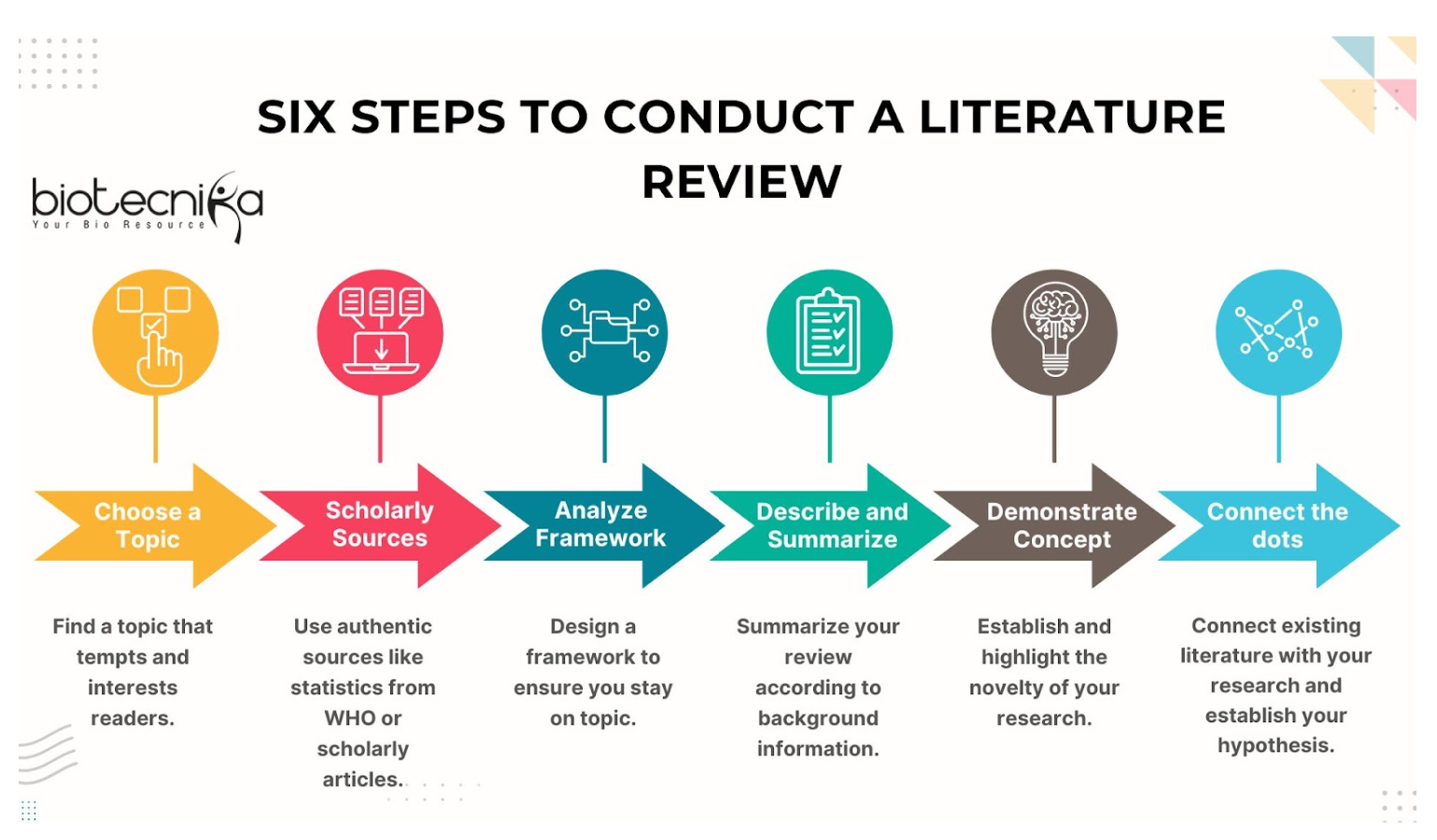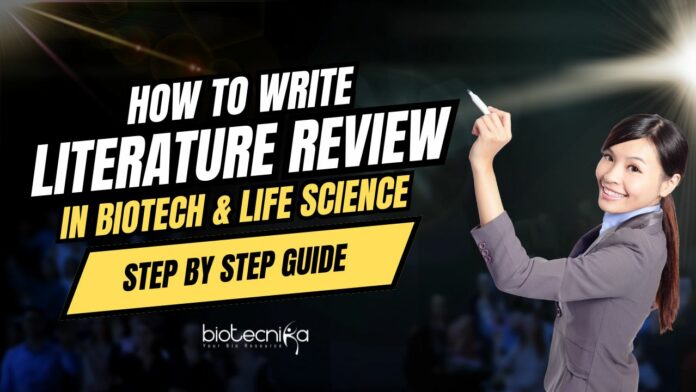Write a Literature Review in Biotech & Life Sciences
A critical component of academic research is conducting a literature review, which is necessary for manuscripts, research proposals, theses, and dissertations. In this article, we will provide a detailed manual outlining common pitfalls to avoid when writing a literature review. This manual seeks to ensure a structured method by helping new and experienced researchers understand the complexities of conducting literature reviews. It covers key aspects such as identifying the research topic, determining the significance of keywords, and exploring different techniques for conducting literature reviews.
Purpose of literature review
- It helps identify gaps in existing research and points out topics requiring more investigation.
- It ensures that the researcher does not repeat work that has already been published, saving both time and resources.
- Assists in refining and focusing the research questions, methodology and ensuring a more directed and effective study.
- Increases the credibility of the research by finding evidence to support the researcher’s findings and conclusions.
Overview of – Types of Literature Review
- Manuscript Reviews: Follow the guidelines given by the journal or publisher, such as Elsevier or Springer, and format your review to match those instructions.
- Analysis Reviews: Collect information from a defined time period and create a structured plan for examining the data, like conducting a comprehensive review.
- Dissertation or PhD Thesis Reviews: These reviews cover everything in detail and need a deep knowledge of the research subject as well as the existing literature.
- General Literature Reviews: These summaries are adaptable and can be flexible for different purposes, like giving an overview about a topic or highlighting crucial research findings.

Conducting an Effective Literature Review
An effective literature review is the one that not only engages the readers but also increases their awareness about the topic.So,to conduct an effective literature review, follow these basic steps:
Effective Electronic Searches
- Start with Focused Keywords: Begin by identifying clear and relevant keywords for your search. This will help in achieving more accurate and better results.
- Utilize Computer User Interfaces: These interfaces look for expected keyword patterns in your search query. The correct pattern ensures that you receive most relevant results.
- Data Mining and Search Engines: Enter your keywords into search engines so that it can efficiently gather information. This URL then scans for websites and databases to retrieve the necessary data.
- Data Cleaning, Selection and Integration: Once the data is gathered, refine and organize it by cleaning, selecting and integrating the information to make it more comprehensive.
Structured Approaches to Literature Reviews
Two major approaches to structuring literature reviews are the inverted pyramid and wine glass approaches.
Inverted Pyramid Approach
The inverted pyramid method begins with a wide subject and then gradually focuses on a specific point, emphasizing the key part of your study. This technique guarantees a clear and logical progression from general background knowledge to specific information.
- Begin with a broad introduction to the subject to give background information.
- Step by step, focus on particular research questions or hypotheses.
- Incorporate studies and literature that are pertinent to your research topic to strengthen your work.
- Conclude by answering the main research question directly.
Avoid reversing this approach because it might result in several confusing outcomes. The aim is to reach a single, straightforward conclusion.
Wine Glass Approach to Write Literature Review in Biotech
The wine glass method, commonly used by journals that follow the IMRAD format (Introduction, Methods, Results and Discussion), organizes literature reviews into separate parts that match the structure of the research paper.
- Start by providing the basic background information then proceed to the main question or idea being investigated.
- Explain the process of reviewing the literature, including how sources were found and chosen.
- Summarize the main results from previous research, highlighting important studies and what they have contributed.
- Finally, examine and understand the outcomes, emphasizing how they relate to the study’s main question.

Challenges faced by new researchers & ways to overcome it
1. Overwhelm by Vast Literature
- Begin by narrowing your topic to specific research questions or hypotheses.
- Create a reading schedule with clear, achievable goals to gradually cover the literature.
- Focus on the most cited and relevant papers in your field first.
2. Overcoming Uncertainty
- To keep the literature review on track, make a structured outline or plan.
- Discuss research related queries to your mentors or peers, they will help in improving your review work.
- Use tools such as concept maps or mind maps to arrange your ideas and plan your review.
3. Sourcing Key Information
- List out key terms from your topic and use them in your searches.
- Use research databases and set filters to specify your search to the most recent studies.
- Look at the references in important articles to discover more related resources.
4. Strategic Time Allocation
- Set aside particular time periods in your plan for doing research on the literature.
- Set individual deadlines for various parts of your literature review to keep yourself on schedule.
- Combine literature review activities with other research tasks to evenly distribute your workload.
5. Synthesizing Information
- Use note making methods like creating tables or summarizing the key points.
- Categorize related information into a group because that will facilitate comprehension and synthesis.
- Regularly write abstracts and summaries because this will help you to integrate and present concepts more effectively.
Do’s and Don’ts: A Guide to Research Paper Writing
Writing a research paper can be a daunting task, but following a set of guidelines can streamline the process and ensure the final product is high-quality. This article will elaborate on the essential do’s and don’ts to keep in mind when crafting a research paper.
Do’s of Writing a Research Paper / Write Literature Review in Biotech & Life SCience
1. Choose a research topic and define your target audience
Start by taking up a clear and specific topic. This helps to maintain a consistent structure thereby making it focussed and relevant throughout. Identify your target audience in advance, and accordingly tailor your tone, intricacy, and style of your work. This gives the ensurity that the content is engaging as well as appropriate for anyone who reads it.
2. Conduct Extensive Reading
To conduct in-depth research, make use of reliable sources like ScienceDirect, Google Scholar and PubMed. These websites offer you access to an array of peer-reviewed articles, books and journals that are crucial for a thorough understanding of the topic.
3. Focus on Contemporary Issues
Make sure that your research addresses the recent advancements and challenges in your field. Thus, this not only makes your paper more interesting but also makes it useful for others who are working on similar or relevant topics..
4. Use Reliable Sources and gather Information
Always rely on authentic sources like academic journals or the world health organization or the Center for disease control. Integrate information from these sources to make your work narrative thereby strengthening the validity of your work.
5. Apply a Systematic methodology
While creating the basic structure of your research paper, focusing on approaches like the inverted pyramid (start with the important details and gradually focus more) or the wine glass (wide start, particular center and wide end) may be useful. This increases your content’s readability and clarity.
6. Detailed Proofreading
Resolving grammatical faults, continuity problems and other potential flaws that could lower the quality of the paper is made simpler when you revise and edit it. Thua,a well edited paper implies your professionalism and commitment towards quality.
Don’ts of Writing a Research Paper
1. Don’t Start Without a Plan
Without a plan, starting a research paper can result in a disorganized and incoherent work. Develop an outline of your paper’s introduction, body and conclusion before you begin writing. This will ensure your writing is organised and focussed.
2. Don’t Use Outdated Sources
Using outdated or irrelevant sources may cause your research to seem less credible. It is always advisable to check the publication dates and go for the most latest and relevant ones to support your part.
3. Don’t Plagiarize
Plagiarism is a serious academic violation with severe consequences. Thus it is important to properly attribute the ideas, data and quotes to the corresponding authors. Plagiarism detection tools are available, which can be used to ensure any kind of unintentional copying, thereby maintaining the originality of the document.
4. Don’t Neglect Keywords
In the absence of effective keywords, your research papers may not appear under search results on academic databases as well as search engines, so this may limit the accessibility and visibility to potential readers. Thus it is advisable to always go for relevant and specific keywords that reflect the content and focus of your paper.
5. Don’t Neglect the Guidelines
Ignoring the formatted guidelines provided by your journal or institution can result in your paper being rejected or may be returned for several rounds of revisions. Make sure you carefully follow these instructions about how to organize your paper, how to cite sources, and how long your paper should be. Following these rules shows that you are serious and considerate about the process of getting your work published.
6. Don’t Ignore Feedback
Neglecting comments from peers, mentors or reviewers can lead to limiting your papers potential. Important feedback plays a crucial role in refining your ideas, clarifying arguments and enhancing the overall quality of your paper. Thus, be ready to listen to suggestions, change what needs to be changed and see feedback as a way to make your study stronger and better.

Length of the literature review
The length of the review depends on whether you’re writing a comprehensive review, a short review, a commentary, or a letter to the editor. Follow the journal or publisher’s instructions for the same.
Final tips
A literature review requires a well defined topic, a comprehension of the intended audience, an in-depth review of the literature, a focus on current issues, and quotes from credible sources. Writing down what you have learnt not only enhances retention but also provides clarity.
To summarize, conducting a literature review requires a systematic and well planned approach. By correctly identifying the target audience and research topic and applying efficient search strategies along with structured techniques, such as the wine glass and inverted pyramid frameworks, a literature review can be made both powerful and informative. Clearly establishing a framework, performing accurate data evaluation and citing only reliable, current sources can make it easier to manage an enormous amount of literature without being overloaded. Researchers can ensure a thorough and significant contribution to the field’s advancement by adhering to these tips.
How to write a literature review; Tips to write a literature review; Guide to write a literature review; Writing a literature review. Write literature review in biotech, biotech literature review writing

































